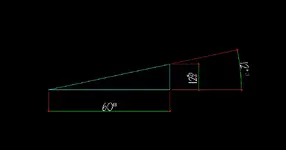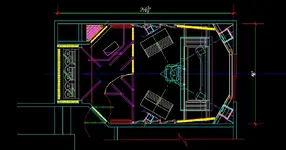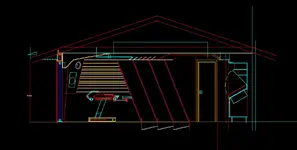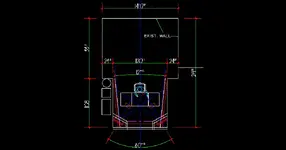But, I suppose even a math moron like me could deduce that I would just cut the number in half to get 6
That was a trick question in school.

Actually, no, the degrees are cut in half, but the distance on the short leg would be 6 5/16". IF the short side were an arc instead, then the length of the arc would be half. As to the 12 degrees or 6 degree per wall, it is 12 degrees TOTAL between the two splayed walls. Sorry, I wasn't awake when I drew that. It should be 6 degrees per wall, or more. At least from my understanding, this is a minimum.
Like I said earlier Jack, the angled walls are mainly to direct the early reflections to a rear wall where they can be absorbed, diffused, diffracted or what ever you would like to do with them.

Ha! just kidding. The main thing is to keep early reflections from the mixing position. Here is why.
The distance from the monitor to your ears is always shorter than the distance a reflection must travel. Therefore, the reflection arrives AFTER the direct sound. This is called a time delay gap. This TDG creates comb filtering which in essence, masks the TDG of the studio, which is exactly what the engineer is trying to hear, as early reflections at the microphone are what gives the recording its room characteristics. However, there are many other things that must be considered to achieve this correct TDG in the control room.
For one, the monitors must be soffet mounted, as near fields diffract sound back to the front wall where they create an early reflection. So does the surface of your console. In rooms where near fields are used, it is necessary to use absorption as a means to eliminate early reflections from the front wall.
Sound travels at approx 1 ft per millisecond. Since the brain will integrate all sounds that arrive at the ears within 25 ms of the direct sound, to create a TDG longer than the studio, sound wave must travel a round trip distance of at least 25 feet , plus the TDG of the studio. For normal rooms, this TDG is created by reflections from the ceiling, as it is usually the closest to the mic, which in normal 8 ft ceilings, and a mic height of 5.5 feet, means a singer would have a TDG of about 5 ms. It is this TDG of the studio that the engineer can hear comb filtering effects and the reflections itself. I'm sure you have heard recordings that illustrate this perfectly. You hear the sound of the room as SIZE, by virtue of these reflections. That is the point of having TALL ceilings in the studio, and keeping the mic away from adjacent walls as far as possible. And how do you tell what it sounds like over the monitors? Exactly. By not masking it with control room early reflections. Hence haveing side walls splayed, and a rear wall at least 25+ feet ROUND TRIP for these reflections. That translates into a rear wall approx 13 to 18 feet from the engineering position.
But let me add something here. Although it is desirable to have an RFZ. attaining it at the engeenering position in small control rooms is dubious, considering the paths for early relection control must be calculated as IMAGE POINTS to establish its boundarys. And early reflections are only part of the overall room acoustics that must be considered.
I've barely scratched the surface of this subject, so please don't consider this a concise explanation. There are volumes written on these subjects and it is difficult at best, especially for someone like me, with no education in acoustics to explain them in a few short paragraphs. And I have probably oversimplified them too. Comb filtering deserves a book chapter in itself.
Well Jack, I hope this helps. I'm certainly no expert, but this is what I've gleened from reading, although I have condensed it. Other more expert people may dispute this with more current knowlege or better understanding.

fitZ
 My first question is this:
My first question is this: My first question is this:
My first question is this:

 Actually, no, the degrees are cut in half, but the distance on the short leg would be 6 5/16". IF the short side were an arc instead, then the length of the arc would be half. As to the 12 degrees or 6 degree per wall, it is 12 degrees TOTAL between the two splayed walls. Sorry, I wasn't awake when I drew that. It should be 6 degrees per wall, or more. At least from my understanding, this is a minimum.
Actually, no, the degrees are cut in half, but the distance on the short leg would be 6 5/16". IF the short side were an arc instead, then the length of the arc would be half. As to the 12 degrees or 6 degree per wall, it is 12 degrees TOTAL between the two splayed walls. Sorry, I wasn't awake when I drew that. It should be 6 degrees per wall, or more. At least from my understanding, this is a minimum.
 ). I have a deep closet at the rear that centers on the width, and that will be a hanger bass trap or a Slat absorber, with corner bass traps. Here is a plan of my space so you can see. I'll post a pic of your plan tonight if you can get the dim's to me in time.
). I have a deep closet at the rear that centers on the width, and that will be a hanger bass trap or a Slat absorber, with corner bass traps. Here is a plan of my space so you can see. I'll post a pic of your plan tonight if you can get the dim's to me in time.

 I'll have to build a double wall, with staggered studs.
I'll have to build a double wall, with staggered studs. But then, you would end up with flat panels at doors and the window, which would probably also cause predominate reflections. Ever tried to build a door jamb for a curved wall? I have. NO fun, especilally when it comes to the header jamb and trim. Baseboard isn't to bad, if you use veneered MDF. But the real test is curving and fastening drywall. Its a BITCH!!
But then, you would end up with flat panels at doors and the window, which would probably also cause predominate reflections. Ever tried to build a door jamb for a curved wall? I have. NO fun, especilally when it comes to the header jamb and trim. Baseboard isn't to bad, if you use veneered MDF. But the real test is curving and fastening drywall. Its a BITCH!! 
